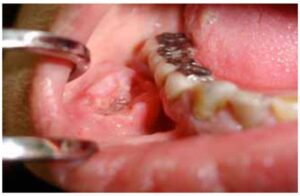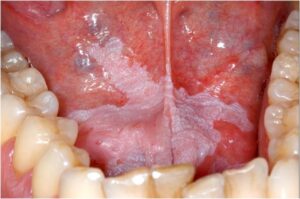Oral Cancer: Signs and Symptoms

Oral ‘cancer‘, as haunting as the word may sound, is one of the commonest cancers affecting the human body. This cancer specifically involves the oral cavity, and can appear anywhere in mouth, which includes:
- Floor of the mouth
- Roof of the mouth
- Tissue lining cheeks and lips
- Teeth
- Gums
- Tongue
- Lips
- Salivary glands
- Back of the mouth
- Lining of the throat

Knowledge to recognize the basic signs & symptoms that come along with this disease followed by timely treatment is a must for everyone, even those who don’t deal with the medical field. So why not give you all a brief insight into ‘what actually is mouth cancer?’, ‘what causes it?’, ‘how to recognize it?’, and ‘what are the treatment options available?’
What Causes Cancer?

Cancer happens when a genetic change in the body results in cells growing without control. This genetic change is called mutation (not the mutation that makes you a member of X-men!). As these unwanted cells continue to grow, they form a tumor. In time, the cells can migrate to other parts of the body. In medical terms, this migration of cancerous cells is referred to as metastasis.

Risk Factors

Following mentioned are a few of the risk factors that may make a person more prone to develop oral cancer:
- Tobacco!!!
- Use of any kind, including cigarettes, cigars, pipes, chewing tobacco, and snuff.
- Alcohol use.
- Betel quid and areca nut
- Excessive sun exposure to lips.
- HPV: a sexually transmitted virus.
- Diet low in vegetables and fruits
- Weakened immune system
Symptoms
Symptoms are features of a disease which the patient can see themselves. So, if cancer develops, a person may notice:
- Patches on the lining of the mouth or tongue, usually red or red and white
- Bleeding or pain
- Mouth ulcers or sores that do not heal
- A lump or thickening of the gums or lining of the mouth
- Loose teeth with no apparent reason
- Swelling in the jaws
- Unexplained, persistent numbness or an odd feeling on the lip or tongue
- A sore throat or feeling that something is stuck in the throat
- A hoarse voice
- Difficulty in chewing or swallowing
- Difficulty moving the tongue or jaw
- Poorly fitting dentures (if anyone is wearing them)
Signs
Signs are features of a disease which the dental practitioner can observe, feel or touch. So, signs which are commonly detectable by the dentist include:
- Oral lichen planus: Areas having white lines with reddish border.

- Leukoplakia: white patches that do not disappear upon rubbing.

Type of Mouth cancer
Oral cancer is categorized by the type of the cell the cancer starts to grow in.
It can either originate from connective tissue (sarcoma) or from epithelium (carcinoma).
The most common type of oral cancer is squamous cell carcinoma which arises from the oral epithelium.
Oral cancer, like anywhere in the body can be either benign or malignant. Benign tumour does not invade nearby tissues or spread to other parts of the body via metastasis. No cancer is considered good, but benign tumours are relatively considered very good, but can become serious if they press on vital structures like nerves or blood vessels.
On the other hand, malignant tumour is a type of cancer which can invade and destroy nearby tissues and spread to other parts of the body via metastasis.
Metastasis can occur via:
- Local invasion of tissues
- Blood system
- Lymphatic system

Treatment:
As any other disease in the textbook, cancer can also be treated, provided its diagnosis is done early. Treatment of oral cancer will depend on the:
- Location of cancer
- Stage of cancer
- Type of cancer
- Spread of cancer to other body parts
- The individual’s overall health
- Personal preferences of patient
A variety of options for treatment of oral cancer are available which include:
- Surgery
To remove the cancerous cells or tumour. In some cases a tiny bit of surrounding normal tissue is also removed to ensure complete removal. - Radiation therapy
In this approach radiographic beams are directed at the cancerous cells to kill them. - Chemotherapy
In this approach strong medicines are used to kill cancerous cells.
These approaches are usually used in combination. For example, after surgery is done, radiotherapy may be used to prevent the cancerous cell to return.
The aim of the treatment to save the patient’s life. On top of this, the patient’s important functions of mouth like breathing, speaking, eating and appearance of mouth are prioritized while treating oral cancers.
Complications
Despite successful treatments in many cases, many side effects or severe complications are likely to arise:
- Bleeding
- Infection
- Pain
- Salivary gland problems
- Change in taste
- Difficulty eating and swallowing
- Mental disturbance
As they say “prevention is always better than cure” I’ll end this here on this note, hoping, just like me, you all will take the preventive measures too.
Prevention
As the famous saying goes that prevention is better than cure. Same is the case with oral cancer as well. Prevention lies in your hands, and it can be prevented by a number of ways:
- Avoid using any form of tobacco product
- Avoid excessive alcohol consumption
- Avoid chewing betel nut
- Maintaining a healthy and balanced diet
- Have a regular dental check up
- Monitor for changes in the mouth and see a dentist

